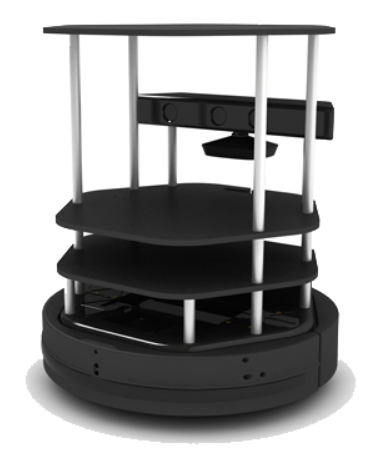3.0.1 TurtleBot Introduction
Course subject(s)
Module 3. Autonomous Navigation
As discussed before, in our factory environment we will have 2 manipulators (robot arms) and a mobile robot. The mobile robot that we will use is the TurtleBot. We will start by introducing this mobile robot.
What is the TurtleBot?
TurtleBot is a mobile robot that can be purchased as a kit or fully assembled. It’s a low-cost, personal robot kit with open-source software. With TurtleBot, you’ll be able to build a robot that can drive around your house, see in 3D, and have enough horsepower to create exciting applications.
The TurtleBot 2 model, which we will use in the simulation, is shown in the following image:

A list of manufacturers can be found at: http://www.turtlebot.com/manufacturers/.
The main items that comprise the TurtleBot 2 model from bottom to top in the preceding image are as follows:
- A mobile base (Kobuki Base) that also serves as support for the upper stages of the robot
- A netbook (ROS Compatible) resting on a module plate
- A vision sensor with a color camera and 3D depth sensor
- Other module plates used to hold items
Overall, the TurtleBot model stands about 420 mm (16.5 inches) high and the base is approximately 355 mm (14 inches) in diameter.
TurtleBot rests on the floor on two wheels and a caster. The base is configured as a differential drive base, which means that when the TurtleBot is moving, the rotational velocity of the wheels can be controlled independently. So, for example, TurtleBot can move back and forth in a straight line when the wheels are driven in the same direction, clockwise (CW) or counterclockwise (CCW), with the same rotational velocity. If the wheels turn at different rotational velocities, TurtleBot can make turns as the velocity of the wheels is controlled.
The vision sensor, as shown in the preceding image of TurtleBot2, is an Xbox 360 Kinect sensor manufactured by Microsoft. Originally designed for video games, the Kinect sensor is a popular vision and depth sensor for robotics.

Hello (Real) World with ROS - Robot Operating System by TU Delft OpenCourseWare is licensed under a Creative Commons Attribution-NonCommercial-ShareAlike 4.0 International License.
Based on a work at https://online-learning.tudelft.nl/courses/hello-real-world-with-ros-robot-operating-systems//.



